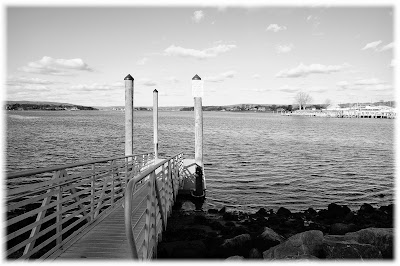I follow a number of photography blogs, and one of my favorites is "
Working Pictures" by Carl Weese. Carl has done some amazing work and is an expert in the process of Pt/Pd printing. Recently he blogged about using his camera to
take monochrome pictures and gave some instructions on how to do this. Basically he set his camera to capture both a JPEG and RAW file for each picture, but would only display the JPEG and his EVF as a black and white picture which would serve as a reminder to him that he was trying to make black and white pictures. I thought I'd give this a try with my Nikon D90 to see what I could learn about looking at a color picture that would make it a good picture when converted to black and white. For the D90, this was pretty easy to do. I always shoot both JPEG(Fine) and RAW. I selected Monochrome for Picture Control, which would display only the monochrome JPEG on the LCD screen. I could then import both the RAW and JPEG into Aperture 3.5 as matched pairs. Since Aperture can't read the all of the NEF instructions, it imports the JPEG as monochrome but the RAW File as the full color capture. This allowed me to directly compare both the color (RAW) version as well as the monochrome (JPEG), side by side. Here is an example of what I did on a recent photo shoot. The first picture is the JPEG, straight from the camera without any post processing. It caught my eye as having some potential as a good Black and White image.

The next image is the color RAW file, with some of my standard adjustments
The final picture is a black and white conversion of the post-processed color version shown above, using Nik Software Silver Fx Pro to produce what I like as a final black and white image.
I think this is a pretty good exercise, and I plan to post a few more examples in the coming week. I know that some good photographers actually visualize their images in black and white. I don't know if I'll ever be able to master that. This exercise might help me though.



Ed, like what you've done with the last image. The contrast is picked up a bit without losing shadow detail. Of the three versions, I think it is the strongest. I handle my b&w images differently as I use Photoshop to convert the color image jpg files into monochrome. When it does that I can lighten or darken the intensity of colors as they translate into b&w. That way I can darken skies a bit without darkening much else in the picture. Carl really knows what he's doing, and I would follow his advice. Yes, I also follow his blog.
ReplyDeleteThanks for your comment on my blog this morning. That Model T truck is a tow truck owned by the fellow in the first picture. He bought it back in the 1960s for less than $20, and he just recently got it running. So it has been sitting in that barn for over half a century. Not bad for a 90 year old vehicle.